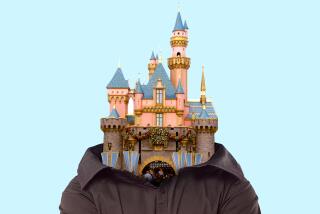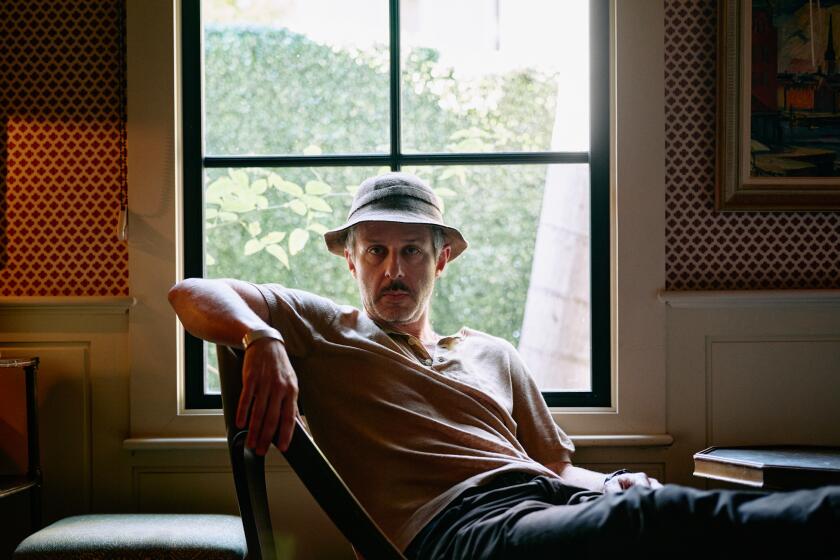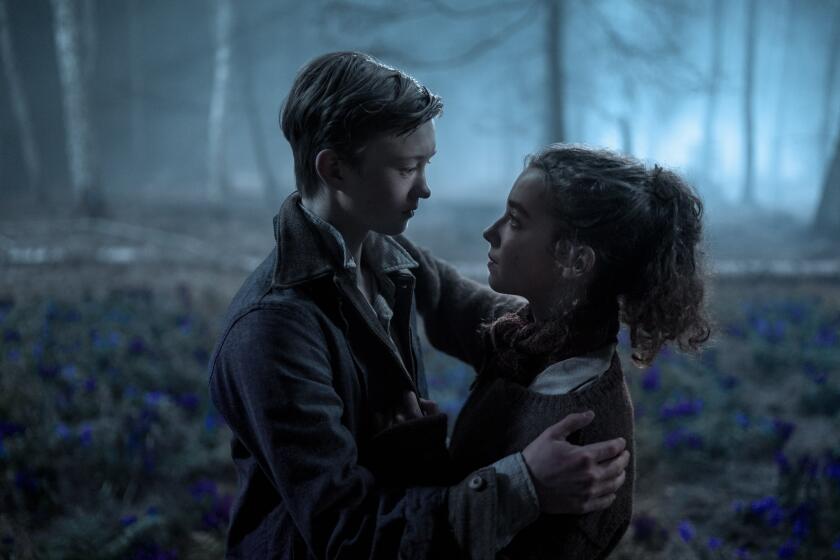It Wasn’t Always Magic : Fifty years ago, Walt Disney dreamed ‘Fantasia’ would make animation an artform, but it wasn’t a legend in its own time
In the 12 years that had passed since Mickey Mouse’s debut in “Steamboat Willie,” the artists working for Walt Disney completely redefined animation, setting the standards by which cartoons are still measured. Disney won the Academy Award for animated short every year from its inception in 1932 through 1939, as well as receiving a special Oscar for “Snow White and the Seven Dwarfs.” Walt also was given an honorary doctorate from Yale and a special citation from the League of Nations for the creation of Mickey Mouse, “an international symbol of good will.”
Disney, having become one of the most famous men in the world, was now set on reaching an even greater plateau. His biggest dream--a film that would use his sophisticated style of animation to introduce mass audiences to the emotional range of classical music--was about to open. He had planned to call it “The Concert Feature,” but changed it to “Fantasia.”
Disney was counting on “Fantasia” to become the hit his studio needed to prove animation a major art form, and, because it was his most ambitious work, he was pretty sure how it would be received.
“No doubt, some unimaginative critics will predict that in ‘Fantasia,’ the animated medium and my artists have reached their ultimate,” Disney wrote before the film premiered. “The truth is to the contrary. ‘Fantasia’ merely makes our other pictures look immature, and suggests for the first time what the future of the medium may well turn out to be.”
Some unimaginative critics did come forward, to be sure, but they didn’t say what Walt expected them to. When “Fantasia” premiered, the printed gasps of outraged critics in New York could be heard all the way to Burbank. Some people were clearly not ready for centaurs and cherubs frolicking to Beethoven.
“Where Disney misses is in the creation of the smirking centaurs, the ‘art calendar’ cupids, the coy and flapperish centaurettes, and the comic-strip Bacchus who all desecrate the Olympian background chosen for Beethoven’s Pastoral Symphony,” wrote the film critic for Newsweek.
”. . . To have the Pastoral Symphony interrupted by applause for sugar-sweet centaurettes is painful,” said Franz Hoellering in The Nation.
Wrote columnist Dorothy Thompson in the New York Herald-Tribune: “The illustrations of the Beethoven ‘Pastoral’ are sufficient to raise an army, if there is enough blood left in culture to defend itself. . . . The clean, pure sounds--the unbearably clean, pure sounds--fall about us while we gaze on the raspberry and marshmallow Olympus, and the pure, strong music seems to be dropping cold and frustrated tears.”
The reviews generally were mixed, and, despite its visual brilliance, “Fantasia” was a disappointment at the box office too. The film had cost almost $2.5 million, about the same as “The Wizard of Oz,” which was released the year before, and it failed to attract the large family audiences that had made “Snow White” a success.
The cool, and sometimes hostile, reaction to his masterpiece was a devastating blow to Disney, and it marked the beginning of his disenchantment with animation. Gradually, he was led into other areas of creativity, including live-action film, television and theme parks that brought him even greater fame and the monetary rewards that had eluded him as an animation producer.
There had been very little to prepare Disney for the critical blows rained on him by critics of “Fantasia.” Between “Steamboat Willie” in 1928 and “Fantasia” in 1940, he had received almost nothing but acclaim. He was breaking new ground, almost with every film, and he had virtually eclipsed Pat Sullivan (Felix the Cat), Max and Dave Fleischer (Koko the Klown) and Paul Terry (Farmer Al Falfa), who were the leaders of the cartoon industry when he came along. By the end of the ‘30s, Mickey Mouse cartoons were so much a part of the filmgoing experience that the phrase, “What, no Mickey Mouse?” was synonymous with disappointment.
Disney cartoons of the ‘30s introduced multiplane camera shots, more imaginative use of camera angles and fluid character and background movement that suggested depth and weight. Ten days before the opening of “Fantasia,” Disney told a New York Times reporter, “Maybe I’m screwy. I don’t know. It isn’t that I deliberately set out to break movie traditions. But if someone didn’t break loose with new things the movies wouldn’t be where they are today. You’d still have ‘Uncle Tom’s Cabin.’ Somebody’s got to be a damn fool.”
It wasn’t the first time Walt Disney had been called “a damn fool,” but he had a right to feel confident: He had gambled twice before on innovative films--and won. He had sold his car and cut his own salary to pay for “Steamboat Willie” and then saw Mickey Mouse become the most popular cartoon character in the world. When he borrowed nearly $1.5 million from the Bank of America to complete “Snow White and the Seven Dwarfs,” skeptics dubbed the film “Disney’s Folly.” “Snow White” had earned more than $8 million--a staggering sum in 1937.
These successes had enabled Disney to launch an unprecedented program of experimentation and production that included classes in drawing, anatomy, motion analyses and acting for his rapidly growing staff of artists. Beginning with the early Mickey Mouse shorts and Silly Symphonies, Disney plowed his profits back into the studio, striving to make his films better. Between 1928 and 1940, he produced more high-quality animated films than any other studio, before or since.
Some of his shorts were so expensive, they took 2 years in release to show a profit, although the sale of Mickey Mouse toys and other character merchandise helped to offset their costs. The profits from “Snow White” enabled Disney to hire more artists, begin more films, accelerate the training program, and build a model studio on a 51-acre plot in Burbank.
“Walt was really reaching for the stars in those days,” says Frank Thomas, one of the Nine Old Men of Disney animation. “The success of ‘Snow White’ really liberated him. He had struggled with the shorts because he could never get enough money to do what he wanted with them; he couldn’t do everything he wanted to in ‘Snow White’ either, but when it made so much money, it really boosted his morale. There was nothing he couldn’t do!”
Disney accelerated his already impressive scale of production during the late ‘30s. He planned to release a new animated feature every year, producing them on a three-year schedule. In addition to “Fantasia” and “Pinocchio,” which was released earlier in 1940, he had nearly a dozen features in various stages of production from 1938 through 1940, including “Dumbo,” “Bambi,” “Peter Pan,” “Jack and the Beanstalk,” “Wind in the Willows,” “Alice in Wonderland,” “Peter and the Wolf,” “Till Eulenspeigel” and sequels to “Bambi” and “Fantasia.”
During the same three years, Disney also produced 45 short cartoons--including the Oscar winners “Ferdinand the Bull” and “The Ugly Duckling” and Oscar nominees “Good Scouts,” “The Brave Little Tailor” and “The Pointer”--and several others regarded as classics: “Mickey’s Trailer,” “Mother Goose Goes Hollywood,” “Goofy and Wilbur” and “The Autograph Hound.” (In 1938, the schedule proved too ambitious, and Disney had to subcontract the Silly Symphony “Merbabies” to a studio run by two old friends, Hugh Harman and Rudy Ising.)
Disney remained at the center of all of this production, supervising and approving everything. He often rummaged through the animators’ waste baskets at night, occasionally retrieving a discarded drawing, which he would pin to the desk with a note admonishing the artist not to throw away “the good stuff.”
“Walt never had any trouble juggling all those projects,” says Thomas. “He had a fantastic memory, but no one ever talks about it--except the guys who were at the studio. He knew each guy, he knew what they were working on and what he had said to them the day before and the day before that, and he never got mixed up.”
“He had an amazing talent that enabled him to work on about 10 different things at the same time,” adds Marc Davis, another of the Nine Old Men. “It’s bewildering to me, because I can’t do it and don’t know anyone else who can. But he had the kind of mind that could just bounce from one thing to another, including all the financial matters. Walt was also kind of a workaholic. After they built the new studio, he frequently spent the night there--he’d wander around the story rooms and so on.”
Nor were Disney’s comments limited to general questions of story and character development. He inspected the animation of every scene in detail.
“I worked with Freddy Moore (one of the studio’s top animators) on ‘Snow White,’ and was lucky enough to hear Walt’s criticisms of his work,” recalls animator Ollie Johnston, who came to the studio in 1935. “He was critical of everything, down to the movement of a finger or whether a character in the foreground should be larger. He almost drove Fred crazy. So in addition to being able to grasp the large problems, he was able to focus in on a lot of the nitty-gritty to build the standards up to what he wanted.”
What Disney wanted in “Fantasia” was something entirely new. Instead of retelling fairy tales or presenting slapstick gags, his animators would blend color, form, movement, choreography and classical music into a new form of entertainment.
But “Fantasia” wasn’t intended to appeal to the “highbrow” audience. Disney was a man of limited education and unsophisticated tastes: He hoped “Fantasia” would bridge the gap between the large, general audiences that had flocked to “Snow White” and the limited world of fine music. In one story meeting, he said, “This film is going to open this kind of music to a lot of people like myself who’ve walked out on this kind of stuff.”
“He became excited about classical music and felt that putting his animation to it would make it appeal to an audience that wasn’t into this kind of music,” says Johnston. “And I think it did. It certainly opened up classical music to a lot of the young guys at the studio. You didn’t have the access to it on the air or through recordings that you do today.”
The idea of using animation to illustrate music instead of presenting a coherent story was both radically new and a logical extension of the format of the Silly Symphonies. “The Skeleton Dance” (1928) and the Oscar-winning “The Old Mill” (1937) had been plotless mood pieces, but Disney wanted to push the concept further in “Fantasia.”
The boom in production during the late ‘30s proved disastrously expensive: By spring of 1940, Disney’s debt to the Bank of America had soared to $4.5 million. But Walt was confident the success of his new features would restore the studio’s finances: “Fantasia” suggested a completely new direction for animation.
“What I see way off there is too nebulous to describe,” Disney noted at the time. “But it looks big and glittering. That’s what I like about this business, the certainty that there is always something bigger and more exciting just around the bend; and the uncertainty of everything else.”
Decades would pass before the glittering future Disney foresaw became reality.
The reviews weren’t entirely negative. There was particular praise for the “Nutcracker,” “Sorcerer’s Apprentice” and “Dance of the Hours” segments. But most critics disliked the abstract visuals set to Bach’s “Toccata and Fugue in D-minor,” the saccharine piety of “Ave Maria” and singled out the Arcadian imagery of the Pastoral sequence for special condemnation.
Compounding the negative reviews and poor box-office turnout at home, the outbreak of World War II cut off the foreign market that had supplied nearly 40% of Disney’s income previously. The studio’s worsening financial situation was exacerbated by a bitterly divisive strike the next year.
“I think we reached an artistic peak on ‘Fantasia’ that we tried to hang on to in the years after the war,” says Johnston, who worked on the Pastoral. “I believe that in the later films, we advanced in the areas of personality animation and delineating relationships between characters, and we found new ways to get entertainment out of that kind of animated acting. But there was no attempt to equal the artistic advances of ‘Fantasia’ and ‘Pinocchio’: There just wasn’t the money or the staff. We had the finest artists in the country at the studio then, and we gradually lost some of them through the strike and the war. I don’t think we ever achieved anything like ‘Fantasia’ again--a picture that was really based on sheer beauty.”
Disney managed to complete “The Reluctant Dragon” (1941), “Dumbo” (1941) and “Bambi” (1942). Although it failed to duplicate the success of “Snow White,” the modest and endearing “Dumbo” made a much-needed profit of $850,000. “The Reluctant Dragon” failed to attract much attention and “Bambi’ lost money on its initial release. Disney began making training films for the armed services and by 1942-43 was turning out over 200,000 feet of film a year, more than six times his greatest pre-war production. The military films saved the Disney studio--barely.
After the war, Disney tried to recapture some of the innovative spirit of “Fantasia” in the so-called “package features”: “Make Mine Music” (1946), “Fun and Fancy Free” (1947) and “Melody Time” (1948). These films featured Dinah Shore, Nelson Eddy and the Andrews Sisters, rather than Leopold Stokowski and the Philadelphia Orchestra, but each segment had a different graphic look, some of them quite original. None of the three did well at the box office, Disney’s debts soared again, and it was only the success of “Cinderella” in 1950 that kept his studio from going under.
“I think the failure of ‘Fantasia’ hurt Walt, because it kept him from experimenting,” says Thomas. “There are some experimental things in the package pictures, but none of them were very well done. If any of those films had gone over, it would have picked him up. He had a lot of experimental ideas, but he didn’t have the money to push any of them. When he tried to do one or two of them in the package pictures, they didn’t go over.”
“I think he finally said to himself, ‘To hell with it, I’m going to have to do another “Snow White” to get out of these doldrums.’ He liked ‘Cinderella’ and he had always felt he should make it, but I’m sure in his own mind he thought of it as a kind of remake of ‘Snow White.’ ”
Disney continued to supervise the animated shorts and features during the ‘50s, but they occupied less and less of his time as his interests drifted toward nature documentaries, live action films, television production and Disneyland. It wasn’t until the late ‘60s that “Fantasia” began to take on the aura of the classic.
Today, the film is regarded as one of the supreme triumphs of the animator’s art, just as Disney predicted and which the newly restored prints confirm. The greater irony, perhaps, is that mass audiences have been introduced to the pleasures of classical music through “Fantasia,” but they were the children and grandchildren of the viewers Disney hoped to reach in 1940. By the time the film found its audience, it was too late for the man who had conceived it.
“Walt was at the height of his powers when he was working on ‘Fantasia’ and ‘Bambi,’ and you would have loved to have seen what he might have done if he hadn’t been cut off by the strike and the war,” says Johnston. “The ‘40s was a very depressing time for him. Imagine a great writer who completes three-quarters of his masterpiece, then is told he has to wait 10 years before he can go back to it.
“The writer could probably never regain his momentum, and that’s the feeling I had about Walt. He never regained the momentum he had on ‘Fantasia.’ ”
More to Read
Only good movies
Get the Indie Focus newsletter, Mark Olsen's weekly guide to the world of cinema.
You may occasionally receive promotional content from the Los Angeles Times.










